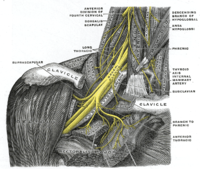
Photo from wikipedia
BACKGROUND The incidence of clavicle fracture in the newborn population ranges from 0.2 to 3.5% with an associated rate of obstetric brachial palsy (OBP) ranging from 4 to 13% .… Click to show full abstract
BACKGROUND The incidence of clavicle fracture in the newborn population ranges from 0.2 to 3.5% with an associated rate of obstetric brachial palsy (OBP) ranging from 4 to 13% . METHODS The aim of this study was to describe the anatomical location of the fracture in the clavicle and its possible correlation with OBP. We retrospectively reviewed all perinatal clavicle fractures diagnosed at our institution over thirteen years. RESULTS A total of 155 clavicle fractures were identified among 23508 live newborns representing an incidence of 0.67% . Fracture location was categorized according to the Allman classification. The most frequent location was the mid-shaft (Allman I) (92.90%), followed by the medial third (Allman III) (5.81%) and finally by the lateral third (Allman II) (1.29%). 17 cases had an associated OBP (10.97%). 13 of these cases (76.47%) involved the medial third, 4 involved the midshaft (23.53%) whilst none of the cases with a clavicle fracture involving the lateral third was associated to OBP. We could determine a significant association between the occurrence of OBP and fracture of the clavicle medial third (Allman type III) (p < 0.05). CONCLUSIONS To the best of our knowledge this is the first study describing the anatomical location of the fracture in the clavicle and its possible association with OBP. A fracture involving the medial clavicle third in a newborn might alert of the possible event of OBP. Nevertheless, more studies with larger samples will be necessary to confirm these results.
Journal Title: Journal of neonatal-perinatal medicine
Year Published: 2018
Link to full text (if available)
Share on Social Media: Sign Up to like & get
recommendations!